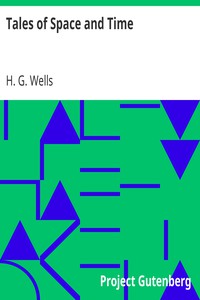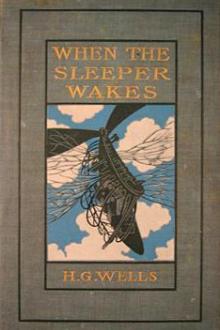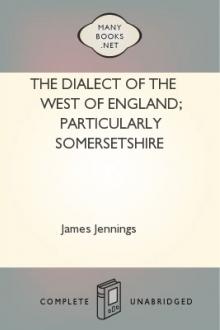Tales of Space and Time, H. G. Wells [best way to read an ebook txt] 📗

- Author: H. G. Wells
Book online «Tales of Space and Time, H. G. Wells [best way to read an ebook txt] 📗». Author H. G. Wells
So having cleared the way, we may give a brief account of this visionary world within the crystal. The things were in all cases seen by Mr. Cave, and the method of working was invariably for him to watch the crystal and report what he saw, while Mr. Wace (who as a science student had learnt the trick of writing in the dark) wrote a brief note of his report. When the crystal faded, it was put into its box[22] in the proper position and the electric light turned on. Mr. Wace asked questions, and suggested observations to clear up difficult points. Nothing, indeed, could have been less visionary and more matter-of-fact.
The attention of Mr. Cave had been speedily directed to the bird-like creatures he had seen so abundantly present in each of his earlier visions. His first impression was soon corrected, and he considered for a time that they might represent a diurnal species of bat. Then he thought, grotesquely enough, that they might be cherubs. Their heads were round, and curiously human, and it was the eyes of one of them that had so startled him on his second observation. They had broad, silvery wings, not feathered, but glistening almost as brilliantly as new-killed fish and with the same subtle play of colour, and these wings were not built on the plan of bird-wing or bat, Mr. Wace learned, but supported by curved ribs radiating from the body. (A sort of butterfly wing with curved ribs seems best to express their appearance.) The body was small, but fitted with two bunches of prehensile organs, like long tentacles, immediately under the mouth. Incredible as it appeared to Mr. Wace, the persuasion at last became irresistible, that it was[23] these creatures which owned the great quasi-human buildings and the magnificent garden that made the broad valley so splendid. And Mr. Cave perceived that the buildings, with other peculiarities, had no doors, but that the great circular windows, which opened freely, gave the creatures egress and entrance. They would alight upon their tentacles, fold their wings to a smallness almost rod-like, and hop into the interior. But among them was a multitude of smaller-winged creatures, like great dragon-flies and moths and flying beetles, and across the greensward brilliantly-coloured gigantic ground-beetles crawled lazily to and fro. Moreover, on the causeways and terraces, large-headed creatures similar to the greater winged flies, but wingless, were visible, hopping busily upon their hand-like tangle of tentacles.
Allusion has already been made to the glittering objects upon masts that stood upon the terrace of the nearer building. It dawned upon Mr. Cave, after regarding one of these masts very fixedly on one particularly vivid day, that the glittering object there was a crystal exactly like that into which he peered. And a still more careful scrutiny convinced him that each[24] one in a vista of nearly twenty carried a similar object.
Occasionally one of the large flying creatures would flutter up to one, and, folding its wings and coiling a number of its tentacles about the mast, would regard the crystal fixedly for a space,—sometimes for as long as fifteen minutes. And a series of observations, made at the suggestion of Mr. Wace, convinced both watchers that, so far as this visionary world was concerned, the crystal into which they peered actually stood at the summit of the endmost mast on the terrace, and that on one occasion at least one of these inhabitants of this other world had looked into Mr. Cave's face while he was making these observations.
So much for the essential facts of this very singular story. Unless we dismiss it all as the ingenious fabrication of Mr. Wace, we have to believe one of two things: either that Mr. Cave's crystal was in two worlds at once, and that, while it was carried about in one, it remained stationary in the other, which seems altogether absurd; or else that it had some peculiar relation of sympathy with another and exactly similar crystal in this other world, so that what was seen in the interior of the one in this world was, under suitable conditions,[25] visible to an observer in the corresponding crystal in the other world; and vice versa. At present, indeed, we do not know of any way in which two crystals could so come en rapport, but nowadays we know enough to understand that the thing is not altogether impossible. This view of the crystals as en rapport was the supposition that occurred to Mr. Wace, and to me at least it seems extremely plausible....
And where was this other world? On this, also, the alert intelligence of Mr. Wace speedily threw light. After sunset, the sky darkened rapidly—there was a very brief twilight interval indeed—and the stars shone out. They were recognisably the same as those we see, arranged in the same constellations. Mr. Cave recognised the Bear, the Pleiades, Aldebaran, and Sirius: so that the other world must be somewhere in the solar system, and, at the utmost, only a few hundreds of millions of miles from our own. Following up this clue, Mr. Wace learned that the midnight sky was a darker blue even than our midwinter sky, and that the sun seemed a little smaller. And there were two small moons! "like our moon but smaller, and quite differently marked" one of which moved so rapidly that its motion was[26] clearly visible as one regarded it. These moons were never high in the sky, but vanished as they rose: that is, every time they revolved they were eclipsed because they were so near their primary planet. And all this answers quite completely, although Mr. Cave did not know it, to what must be the condition of things on Mars.
Indeed, it seems an exceedingly plausible conclusion that peering into this crystal Mr. Cave did actually see the planet Mars and its inhabitants. And, if that be the case, then the evening star that shone so brilliantly in the sky of that distant vision, was neither more nor less than our own familiar earth.
For a time the Martians—if they were Martians—do not seem to have known of Mr. Cave's inspection. Once or twice one would come to peer, and go away very shortly to some other mast, as though the vision was unsatisfactory. During this time Mr. Cave was able to watch the proceedings of these winged people without being disturbed by their attentions, and, although his report is necessarily vague and fragmentary, it is nevertheless very suggestive. Imagine the impression of humanity a Martian observer would get who, after a difficult process of preparation and with considerable[27] fatigue to the eyes, was able to peer at London from the steeple of St. Martin's Church for stretches, at longest, of four minutes at a time. Mr. Cave was unable to ascertain if the winged Martians were the same as the Martians who hopped about the causeways and terraces, and if the latter could put on wings at will. He several times saw certain clumsy bipeds, dimly suggestive of apes, white and partially translucent, feeding among certain of the lichenous trees, and once some of these fled before one of the hopping, round-headed Martians. The latter caught one in its tentacles, and then the picture faded suddenly and left Mr. Cave most tantalisingly in the dark. On another occasion a vast thing, that Mr. Cave thought at first was some gigantic insect, appeared advancing along the causeway beside the canal with extraordinary rapidity. As this drew nearer Mr. Cave perceived that it was a mechanism of shining metals and of extraordinary complexity. And then, when he looked again, it had passed out of sight.
After a time Mr. Wace aspired to attract the attention of the Martians, and the next time that the strange eyes of one of them appeared close to the crystal Mr. Cave cried out and sprang away, and they immediately turned on[28] the light and began to gesticulate in a manner suggestive of signalling. But when at last Mr. Cave examined the crystal again the Martian had departed.
Thus far these observations had progressed in early November, and then Mr. Cave, feeling that the suspicions of his family about the crystal were allayed, began to take it to and fro with him in order that, as occasion arose in the daytime or night, he might comfort himself with what was fast becoming the most real thing in his existence.
In December Mr. Wace's work in connection with a forthcoming examination became heavy, the sittings were reluctantly suspended for a week, and for ten or eleven days—he is not quite sure which—he saw nothing of Cave. He then grew anxious to resume these investigations, and, the stress of his seasonal labours being abated, he went down to Seven Dials. At the corner he noticed a shutter before a bird fancier's window, and then another at a cobbler's. Mr. Cave's shop was closed.
He rapped and the door was opened by the step-son in black. He at once called Mrs. Cave, who was, Mr. Wace could not but observe, in cheap but ample widow's weeds of the most imposing pattern. Without any very[29] great surprise Mr. Wace learnt that Cave was dead and already buried. She was in tears, and her voice was a little thick. She had just returned from Highgate. Her mind seemed occupied with her own prospects and the honourable details of the obsequies, but Mr. Wace was at last able to learn the particulars of Cave's death. He had been found dead in his shop in the early morning, the day after his last visit to Mr. Wace, and the crystal had been clasped in his stone-cold hands. His face was smiling, said Mrs. Cave, and the velvet cloth from the minerals lay on the floor at his feet. He must have been dead five or six hours when he was found.
This came as a great shock to Wace, and he began to reproach himself bitterly for having neglected the plain symptoms of the old man's ill-health. But his chief thought was of the crystal. He approached that topic in a gingerly manner, because he knew Mrs. Cave's peculiarities. He was dumbfounded to learn that it was sold.
Mrs. Cave's first impulse, directly Cave's body had been taken upstairs, had been to write to the mad clergyman who had offered five pounds for the crystal, informing him of its recovery; but after a violent hunt in which her[30] daughter joined her, they were convinced of the loss of his address. As they were without the means required to mourn and bury Cave in the elaborate style the dignity of an old Seven Dials inhabitant demands, they had appealed to a friendly fellow-tradesman in Great Portland Street. He had very kindly taken over a portion of the stock at a valuation. The valuation was his own and the crystal egg was included in one of the lots. Mr. Wace, after a few suitable consolatory observations, a little off-handedly proffered perhaps, hurried at once to Great Portland Street. But there he learned that the crystal egg had already been sold to a tall, dark man in grey. And there the material facts in this curious, and to me at least very suggestive, story come abruptly to an end. The Great Portland Street dealer did not know who the tall dark man in grey was, nor had he observed him with sufficient attention to describe him minutely. He did not even know which way this person had gone after leaving the shop. For a time Mr. Wace remained in the shop, trying the dealer's patience with hopeless questions, venting his own exasperation. And at last, realising abruptly that the whole thing had passed out of his hands, had vanished like a vision of the night, he returned[31] to his own rooms, a little astonished to find the notes he had made still tangible and visible upon his untidy table.
His annoyance and disappointment were naturally very great. He made a second call (equally ineffectual) upon the Great Portland Street dealer, and he resorted to advertisements in such periodicals as were likely to come into the hands of a bric-a-brac collector. He also wrote letters to The Daily Chronicle and Nature, but both those periodicals, suspecting a hoax, asked him to reconsider his action before they printed, and he was advised that such a strange story, unfortunately so bare of supporting evidence, might imperil his reputation as an investigator. Moreover, the calls of his proper work were urgent. So that after a month or so, save for an occasional reminder to certain dealers, he had reluctantly to abandon the quest for the crystal egg, and from that day to this it remains undiscovered. Occasionally, however, he tells me, and I can quite believe him, he has bursts of zeal, in which he abandons his more urgent occupation and resumes the search.
Whether or not it will remain lost for ever, with the material and origin of it, are things equally speculative at the present time. If the[32] present purchaser is a collector, one would have expected the enquiries of Mr. Wace to have reached him through the dealers. He has been able to discover Mr. Cave's clergyman and "Oriental"—no other than the Rev. James Parker and the young Prince of Bosso-Kuni in Java. I am obliged to them





Comments (0)